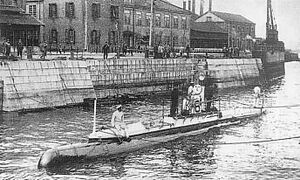Engineering:Japanese Type 6 submarine
 Holland-type submarine No.6
| |
| Class overview | |
|---|---|
| Builders: | Kawasaki Dockyards, Kobe |
| Operators: |
|
| Preceded by: | Kaigun Type 1 class |
| Succeeded by: | Ha-1 class |
| In commission: | 1906–1920 |
| Completed: | 2 |
| Retired: | 2 |
| General characteristics | |
| Type: | Submarine |
| Displacement: |
|
| Length: |
|
| Beam: |
|
| Draft: |
|
| Installed power: |
|
| Propulsion: |
|
| Speed: |
|
| Range: |
|
| Test depth: | 30.5 metres (100 ft) |
| Complement: | 16 officers and enlisted |
| Armament: | 2 × 18 in (460 mm) bow torpedo tubes (2 × torpedoes) |
The No.6-class submarine (第六型潜水艦 Dairoku-gata sensuikan) was the first class of submarines of the Imperial Japanese Navy built domestically in Japan. Consisting of two vessels, these submarines were highly modified versions of Holland-class vessels designed in the United States.
Background
During the Russo-Japanese War, the Japanese government had purchased five modified Holland-class submarines from the Electric Boat Company's Fore River Shipyards in Quincy, Massachusetts.[1] These vessels, known as the Type 1 class were delivered to Japan in knock-down form, and re-assembled at the Yokosuka Naval Arsenal.[2] However, simultaneously, the Japanese government had obtained copies of the blueprints for the Holland-class submarines, and had assigned Kawasaki Dockyards in Kobe the task of building similar vessels in Japan.
Construction and operational history
Kawasaki built two boats (Hulls No. 6 and 7), with the help of two American engineers, Chase and Herbert, who had been assistants to John Philip Holland. The Kawasaki-built submarines displaced 63 or 95 tons when submerged, and measured 73 or 84 feet in overall length, respectively, and were thus longer and displaced less than the original five imported Holland-type submarines which had arrived that same year. However, they had almost double the engine power, which gave extra speed and reduced fuel consumption. On the other hand, both vessels could launch only one 18-inch torpedo, and each was manned by 14 sailors, whereas the imported Holland-type submarines could fire two torpedoes and could be operated by 13 sailors.[1]
The Kaigun Holland #6 was launched at Kobe on 28 September 1905 and was completed six months later at Kure as the first submarine built in Japan. It sank during a training dive in Hiroshima Bay on 15 April 1910. Although the water was only 58 feet deep, there were no provisions for the crew to escape while submerged. The commanding officer, Lieutenant Tsutomu Sakuma, patiently wrote a description of his sailor's efforts to bring the boat back to the surface as their oxygen supply ran out. All of the sailors were later found dead at their duty stations when this submarine was raised the following day. The sailors were regarded as heroes for their calm performance of their duties until death,[3] and the submarine was preserved as a memorial in Kure Until it was dismantled by order of the SCAP in late 1945.[1]
Ships in class
- Japanese submarine No-6 (第六潜水艇 Dai-roku sensuikan), laid down 24 November 1904; launched 28 September 1905; commissioned 30 March 1906; reclassified as 2nd class submersible on 4 August 1916, reclassified as 3rd class submarine on 1 April 1919; decommissioned on 1 December 1920. Became a Memorial at Kure Naval Arsenal.[4]
- Japanese submarine No-7 (第七潜水艇 Dai-nana sensuikan), laid down 26 November 1904; launched 28 September 1905; commissioned 30 March 1906; reclassified as 2nd class submersible on 4 August 1916, reclassified as 3rd class submarine on 1 April 1919; decommissioned on 1 December 1920.[4]
Notes
- ↑ 1.0 1.1 1.2 Jentschura p. 160
- ↑ "Quincy's Shipbuilding Heritage". thomascranelibrary.org. http://thomascranelibrary.org/shipbuildingheritage/history/historyindex.html. Retrieved 16 July 2010.
- ↑ Baldwin pp.92-110
- ↑ 4.0 4.1 Nishida, Materials of the Imperial Japanese Navy
References
- Chesneau, Roger (1985). Conway's All the World's Fighting Ships 1906–1921.. Naval Institute Press. ISBN 0-87021-907-3.
- Evans, David C.; Peattie, Mark R. (1997). Kaigun: Strategy, Tactics, and Technology in the Imperial Japanese Navy, 1887-1941. Annapolis, MD: Naval Institute Press. ISBN 0-87021-192-7.
- Howarth, Stephen (1983). The Fighting Ships of the Rising Sun: The Drama of the Imperial Japanese Navy, 1895-1945. Atheneum. ISBN 0-689-11402-8.
- Jentsura, Hansgeorg (1976). Warships of the Imperial Japanese Navy, 1869-1945. Annapolis, MD: Naval Institute Press. ISBN 0-87021-893-X.
- Roberts, John (ed). (1983). 'Warships of the world from 1860 to 1905 - Volume 2: United States, Japan and Russia. Bernard & Graefe Verlag, Koblenz. ISBN 3-7637-5403-2.
- Schencking, J. Charles (2005). Making Waves: Politics, Propaganda, And The Emergence Of The Imperial Japanese Navy, 1868-1922. Stanford University Press. ISBN 0-8047-4977-9.
External links
- Nishida, Hiroshi. "Materials of IJN". Imperial Japanese Navy. http://admiral31.world.coocan.jp/e/stc0502.htm.
 |

